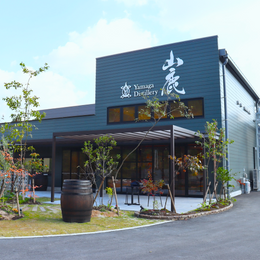A Deep Dive Into Shindo Lab: Inside Shinozaki's Shindo Distillery's (新道蒸溜所) Eternal Search For New Paths On Its Quest For The Original

Kunikiku Amazake (国菊甘酒), Hiramatsu Sake (比良松), Sen Nen No Nemuri Mugi (Barley) Shochu (千年の眠り), Takamine Koji Whiskey, Amagi Rum, Shindo Japanese Whisky - these are just some of the popular things Shinozaki makes.
Shinozaki (or Shinozaki Shoten in full, and 篠崎 in Japanese) makes a whole lot of things - and we mean, a lot. And whilst it's easy to shrug that off as a matter of mere quantity over all else, that couldn't be the further from the truth here. The truth is Shinozaki is really good at the many things it makes - and for the many things it does, it's also somehow rather elusive. Information on Shinozaki is sparse, even as its multitude of sakes, shochu's, and more recently whiskies, rums, gins, and even wines, are entirely accessible, many of which are in fact cult favourites.


Shinozaki's first breakthrough with the Kunikiku Amazake.
Take for example Kunikiku which is the No. 1 Amazake in Japan - a style of low alcohol / non-alcohol Sake of historical origins, or how about Sen Nen No Nemuri, which is a highly reputable Shochu, whose name translates literally as "A Thousand Years of Sleep", regularly counted as one of the great Shochu's of Japan. And then we have Takamine Whiskey which is - get this - a Koji fermented whiskey that taps on a pioneering yet historic effort by Dr Jokichi Takamine that was devised in the late 1800's, which sought to revolutionise whiskey making in the US - some tout Dr Takamine as the original unsung Japanese pioneer in whiskymaking.
Considering the wide breadth of what Shinozaki has found itself incredibly successful at, it's worth asking ourselves what exactly is this secret sauce that Shinozaki holds that almost imbues this Fukuoka producer with a sort of Midas' touch.
So who is Shinozaki?

Shindo Lab and Asakura Distillery side by side.
Let's get into it! Shinozaki was founded by the Shinozaki family some 220 years ago in the late Edo Period as a Sake brewery based in the fertile lands of Asakura (with top quality spring waters supplied by the Aso mountains, which runs through the Chikugo River, the largest river in Kyushu), in the Fukuoka Prefecture of Japan's southern Kyushu region.
Not much details are spared as to the first century of its operations, although it is known that around the early 1900's, the Sake brewery had found success with its Kunikiku brand of Sake, which it began to officially promote. By 1980, the brewery would tap into a rising demand for low-alcohol Amazake - a thick porridge-like Sake made primarily from rice koji that has been enjoyed for over 1,000 years in Japan, and is said to have great health benefits, going so far as to be nicknamed rice yogurt. In appearance Amazake may look like Nigori (or even Doburoku), a style of coarsely filtered Sake, yet Amazake has a much lower alcoholic content as a result of including less rice in the ferment, thereby resulting in lesser starch and sugars that can be turned into alcohol during fermentation. Low-alcohol aside, Shinozaki would also produce the Hiramatsu brand of premium Sake, which too went on to be incredible popular and highly regarded, with a high point being its selection as the house pour for the 2015 World Economic Forum in Davos. This 40 year run of success spurred Shinozaki's tagline "Using Koji to excite people around the world".

Shinozaki Brewery workers in the Showa Period.
Now in the same year - 1980 - Shinozaki would obtain a license to produce Shochu. It was then that Shinozaki would begin producing in particular barrel-aged barley (or Mugi) Shochu, which it also found great success with.
At this point, it's worth taking pause to delve into Shinozaki's philosophy that is arguably what has allowed it to achieve such success across a variety of categories. For one, Shinozaki has an intense desire to be original - in fact, it would later debut a new, more forward-looking motto, "The Quest For The Original". But wait, before things go astray, Shinozaki is quick to caveat that their quest for originality, which is largely informed by their 200 years worth of experiences with trends and fads that have seen booms and busts, is tempered with a strong dose of realism and practicality - Shinozaki even states on their website, "Throw away fixed ideas such as "this is how it's normally done" or "this is impossible" and think flexibly to do everything you can to realize your ideals... We approach all work honestly and carefully, without getting carried away with unusual ideas or methods." And so the brewery / distillery makes a great emphasis on how it's goal is to transcend trends and to stamp out the unpredictable, which they believe is only possible by Shinozaki's pursuit of unique products.

It seems like Shinozaki's got that magic touch!
This ethos has thus been carried out into the 2000's with the division of Shinozaki into two separate units - the Asakura Distillery (which houses the company's traditional and legacy products such as Sakes and Shochu) whose goal is to preserve the "timeless classics", and then there's the Shindo Lab (which houses the Shindo Distillery, producing whisky, gin and rum, as well as Shindo Wines, which produces natural wines) which is charged with creating new innovation. Yet no matter the division, all of Shinozaki's efforts are held to high standards of production quality, with a huge focus on hygiene management and ensuring that the drinks are packaged carefully, whilst also constantly engaging in quality control with the use of detailed data and analysis. Production aside, Shinozaki is also incredibly proud of their community efforts, where the company has often sought to support locals.

Michiaki Shinozaki.
Moving into the 2000's, Shinozaki has since been led by 8th generation Michiaki Shinozaki (篠崎 倫明, or Tomoaki Shinozaki as stylised in English), who has been incredibly integral in pushing the family's business into modernity - and is the man behind the creation of Shindo Lab. Shinozaki-san had initially wanted to pursue being a lawyer, yet eventually decided to join the family's business having been inspired by his father's deep passion for producing great drinks.
Michiaki Shinozaki has pursued many endeavours with Shindo Labs, from using locally sourced Asakura sugarcane to produce Fukuoka's first ever 100% kokuto rum (that is, boiling pressed sugarcane juice into Okinawa-style black sugar, allowing it to open ferment for 15 days with Sake yeast, before running a double pot distillation, after which it was aged for 9 years), to creating a craft gin with lemongrass, peppermint and sencha green tea botanicals, that's then distilled with barley Shochu as a base spirit. More recently he's begun producing natural wines, made with organically grown estate grapes from Ukiha City in the same Fukuoka Prefecture.

Dr Jokichi Takamine.
Yet it is perhaps his Koji fermented Takamine whiskey that has caught him the most attention. Shinozaki-san had in his research learnt of Dr Jokichi Takamine, who was born in Japan's Toyama Prefecture, and had later been sent to the UK to study industrial engineering in the late 1800's (some 35 years before Masataka Taketsuru, the Father of Japanese Whisky, who would later establish Nikka Whisky, had been fatefully sent to Scotland to bring back the practice of distilling whisky), where he would later be recruited to the US to work on Koji products (Koji being the bacteria strain that enables saccharification of starch into sugar, with one of its most famous use being that of turning the starch in rice into fermentable sugars, thereby allowing for the production of Sake and Shochu - arguably one of the most important mechanisms in Japan! It's also used for producing soy sauce and miso.).
Dr Takamine would eventually be hired by the Illinois Whiskey Trust, the largest alcoholic spirits maker in America at the time (owning 65 distilleries in the US, producing 80% of all spirits in America), where he was charged to find a more efficient way to make whisky, thereby skipping the barley malting process. As it turns out, the "Takamine Process" as it was called, could speed up the "malting" process, be applied to any base ingredient or mashbill (even those that did not conventionally malt, such as rice, widening the possibility of grains that could be turned into whiskey) and also produce more alcohol than traditional malting - this would have had a good chance of revolutionising the entire American whiskey industry, if not whiskies as a category altogether. Yet, in an incredibly suspicious and still highly debated turn of events, the Manhattan Distillery that Dr Takamine had produced whisky at with his new methods was burnt down. The project ceased, yet Dr Takamine would persist on, eventually turning his genius to other great achievements such as isolating the Adrenaline compound Epinephrine, which is used widely in medicine today, saving countless lives.

A reinvention of whiskey.
And so fast forward a century into the future, Shinozaki-san had been deeply interested in reviving the Takamine Process (his own father, the 7th-generation Shinozaki, too had been an ardent fan of Dr Takamine's work), which played well into his family's business' motto of using Koji to excite people and to also endeavour in producing something unique - at the time, and as far as is understood at the moment, no other distiller has sought to produce Koji fermented whiskey on the same scale as Shinozaki. Shinozaki would thus approach the Takamine Family Trust to gain permission to the use the "Takamine" name, and to list the use of the Takamine Process in the subsequently debuted Takamine Whiskey, which has been distributed globally. Delving into the specifics, Shinozaki's Takamine Whiskey skips the traditional malting process (which sees the barley boiled and malted for fermentation), and instead inoculates steamed barley with white Koji (there's also black, yellow and red Koji, used for different flavours and purposes), allowing for the barley to saccharify (turning barley starch into sugar) for two days before it is then fermented with yeast, resulting in multiple parallel fermentations. Finally the fermented mash is double-distilled in stainless steel pot stills at atmospheric pressure, after which Shinozaki then ages it in an assortment of barrels (from the more conventional ex-Bourbon to the more unique Sakura) for 8 to 16 years before bottling.
It's worth noting that Shinozaki's approach is a modification (or a reinterpretation rather) of what would have been Dr Takamine's effort in the late 1800's - Shinozaki uses barley instead of say wheat or corn, and also makes use of white barley koji rather than a Sake-style koji - leaning closer towards Shinozaki's expertise in barley Shochu-making. Yet what has remained the same as in the time of Dr Takamine is just how hotly debated Takamine Whiskey is - under current whiskymaking laws and regulations, and to a major extent customer perceptions as well, it toes a thin line as to whether or not it can be classified as, or is even seen as, whiskey. Yet, this revival has been met with great interest, if not curiosity, and has certainly done a spectacular job of winning people over with its unique citrusy and earthy, mildly funky flavours. Regardless, Dr Takamine's work is still deeply convincing of just how close he was to potentially having changed the industry altogether, and is thus often billed as the "What If" Japanese distiller who reinvented a new type of whisky.

Each of these endeavours clearly paints the picture of Michiaki Shinozaki being a man who is undaunted by the unprecedented, whilst at the same time, having no qualms in pulling out all the stops to ensuring that each project is seen the whole way through without any compromise on quality, regardless of the complexity involved. As his family's ethos proudly proclaims, Shinozaki-san strives for the unique, and is methodical, meticulous and patient to boot.
It should be of no surprises then that in 2021, he would establish Fukuoka's first whisky distillery (by conventional standards, that is) - the Shindo Distillery (新道蒸溜所), with its name both taken from the land on which it is on, as well as the name itself meaning "New Road" in Japanese. Its logo is thus a forward winding path that is flanked by a gleaming star. Wanting to capitalise on the massive interest in Japanese whiskies that's emerged in the recent years, Shinozaki-san had thus decided to embark on yet another endeavour that would extend his family's innovative drinks production, which has thus culminated in the Shindo Distillery that sits within the Shindo Labs division.

Shindo Distillery.
Yet as with all Shinozaki ventures, their approach to Shindo Distillery comes in incredibly detailed and meticulous. In the same vein as their Shochu peers who've taken to distilling whisky, Shinozaki aims to leverage its Shochu experience to produce its whiskies - singularly focused, with no desire to look outside for additional advice or experience, so as to squarely focus on forging their own unique path with an approach entirely based on their own beliefs and experience - and in particular a whisky that doesn't just express the same broad flavours of whiskies, but to also enhance and bring out the more subtle flavours in order to create a multi-layered, complex and aromatic whisky.
And so to achieve that, Shindo enlisted the help of Japan's premier distillation still maker, Miyake, who has made for Shindo twin copper pots, with a unique configuration of the wash still featuring a straight head and the spirit still sporting a lantern shape, both with downward lyne arms and shell and tube condensers. The set up is computer controlled which allows the distillery staff to carefully monitor and tweak the process, which the distillery has said will continue to be an intensive R&D process, particularly as Fukuoka experience large temperature differences through the four seasons, and thus the team continues to accumulate data to ensure consistency along the way.

Shindo Distillery's stills.
Shindo primarily uses imported Scottish barley for its distillation, and has experimented with different types of malted barley, however one month a year, the distillery focuses entirely on producing a heavily peated spirt (50 ppm), with the rest of the year dedicated to non-peated spirit production. The barley is mashed in a stainless steel semi-lauter tun that utilises a proprietary mashing technique, with fermentation done in stainless steel tanks fitted with water jackets, using a combination of proprietary yeast developed from Shinozaki's Sake-making, and very uniquely, imported fresh pressed yeast. According to Shindo, the proprietary yeast is said to add "milky, toffee and fresh grassy notes", whereas the fresh pressed yeast (which has an incredibly short shelf life and needs to be specially stored in a 0 degree refrigerator) which it imports from Scotland offers more vibrant and softer aromas as compared to the industry standard dried yeast.

Speaking to notable Japanese whisky expert Stefan van Eycken, Shinozaki-san had talked about how the distillation enjoys a "golden time" that happens about 3.5 hours into the second distillation, where an "unmistakable aroma of honey and coconut, and a heavy, sweet flavour comes through", this being the exact flavour character that Shindo is endeavouring to capture in its new make. As a result Shindo is incredibly proud of its new make which it describes as rich, sweet, layered and complex, and with superb depth - Shindo believes its new make to be its super power and wants it to be channelled through to the final whisky.

The spirit produced is then filled into an array of cask types selected to complement the character of Shindo Distillery's spirit. Whilst most of its ageing is done in ex-Bourbon, with ex-Sherry being a distant second, Shindo has also set aside some more unique casks ranging from Chestnut, to ex-Calvados, ex-Wine, ex-Cognac, as well as casks previously filled with Shinozaki Shoten's own famous Mugi Shochu, Umeshu and Rum, and of course Japan's favourite Mizunara.
Shindo Distillery has also begun the long term effort of growing its own local barley, seizing its fertile and arable land, as well as having begun planting Mizunara oak in the mountainous forests of Hita, along the border of Oita Prefecture, which they hope to use for barrels in the distant future.

Asakura, Fukuoka Prefecture.
The distillery has sought to set its whisky releases at a high alcoholic proof, hoping to aim for at least 50% ABV, so as to deliver fully on flavour, and has also designed its own unique bottle that is shaped like a lantern to pay tribute to its distillation still, with also an indentation running from the body of the bottle up to its neck, as well as featuring a grooved texture along its surface. The bottle design is said to symbolise Shindo Distillery's aspiration to rise together with its local peers of over a hundred Japanese distilleries, as they work towards their goals as one, whilst each remaining true to their own passion. The label design is deliberately minimalist and simple, so as to evoke being approachable, whilst much more detailed information is charted out at the back, again capturing Shindo's hope of making whiskies more friendly and embracing of its customers.
"I feel a lot of pressure and anxiety. *laughs* But of course, there's also the joy of seeing something we've spent so much time creating with my colleagues finally being released to the world. We are grateful to the great pioneers and makers who paved the way for us to be here today. We approach each product we release, and its quality, with intention and responsibility, and we are committed to keeping the spirit of craft alive as we move forward. We hope that our Shindo whisky will spark many conversations, and even if it is not the main topic, we would be delighted if our whisky could be by your side."
Michiaki Shinozaki

In 2024, Shindo opened an on-premise shop alongside its distillery, which also serves as a visitor center that uniquely allows fans to hand-fill their own Shindo whisky, an activity that Shindo found popular in Scotland, whilst remaining uncommon in Japan, and thus had wanted to bring the practice over. The store, Shindo Lab Stand, had sought the creative direction of Seiji Ono, founder of Concept Conception, a popular Japanese design direction company, along with the store's design being produced by Hirokazu Yamazaki, a notable interior designer and guitarist with the rockband Toe, which regularly performs at Japan's incredibly popular Fuji Rock festival.
With Shindo Distillery having begun filling its casks in 2021, it was thus finally in June 2024 that it would begin to debut its first Japanese Single Malt Whisky (having met the 3 year ageing requirement)!

Interestingly, Shindo had decided to name its first series of Japanese single malt whiskies Shindo Experimental, again reflecting the distillery's constant desire to meticulously study its processes and apply data-driven insights to crafting their ideal whisky, which it believes it has not yet achieved but is working towards.
Shindo Distillery thus debuted the Shindo Experimental 01 (read as "Shindo Experimental Zero One"), bottled at 50% ABV, and represents a non-peated blend of 91% ex-Bourbon, 4% Sherry, 4% Mizunara and 1% Refill Scotch barrel aged whiskies produced by Shindo Distillery.
It has since touted the release of Shindo Experimental 02, as well as a new series called Experimental for Cores, which is designed for fans to continue to engage with Shindo in trying its unique spirits.

@CharsiuCharlie






